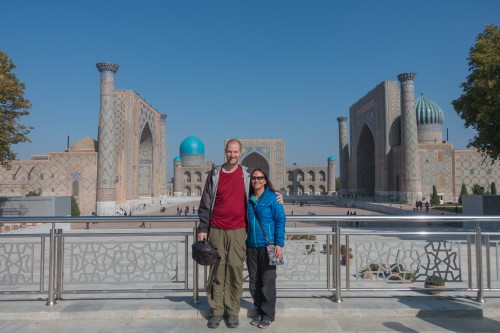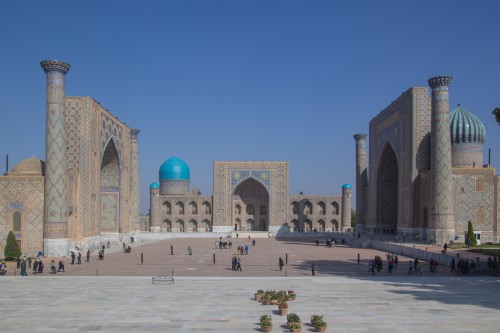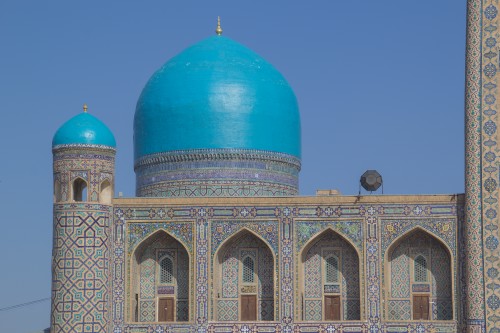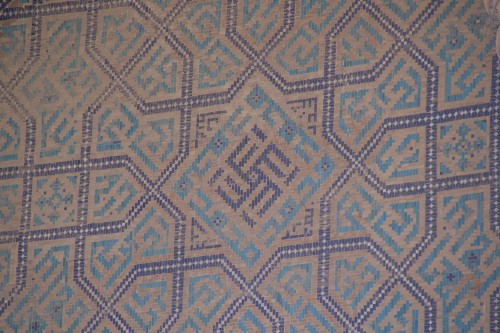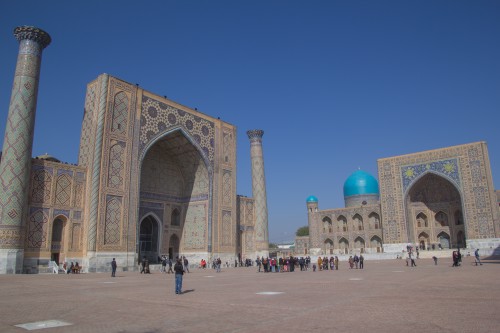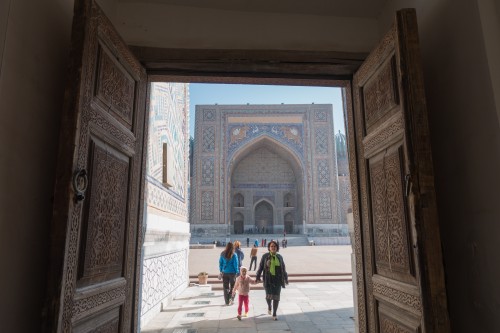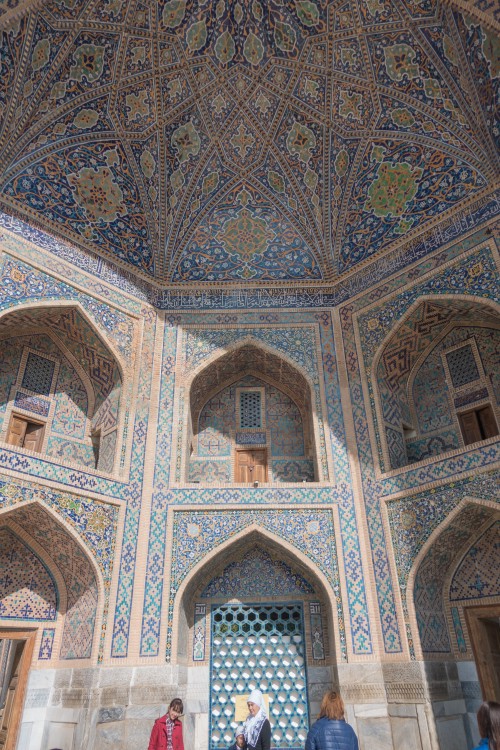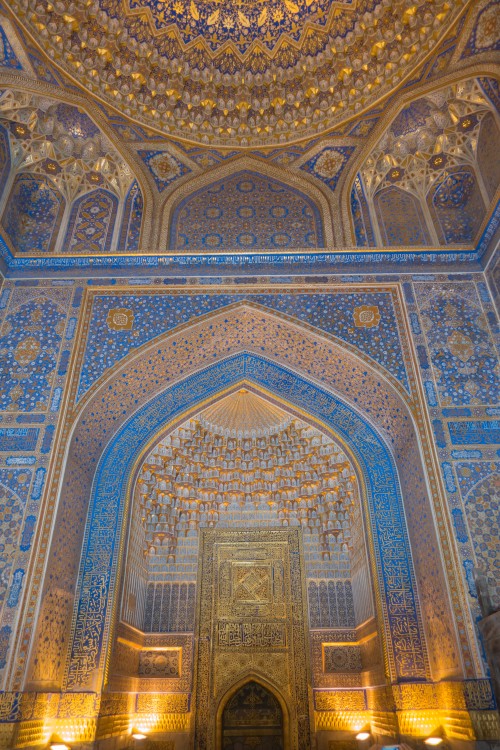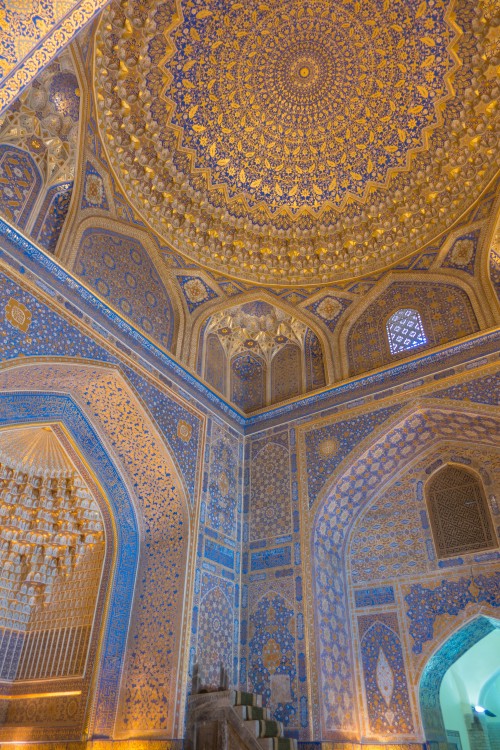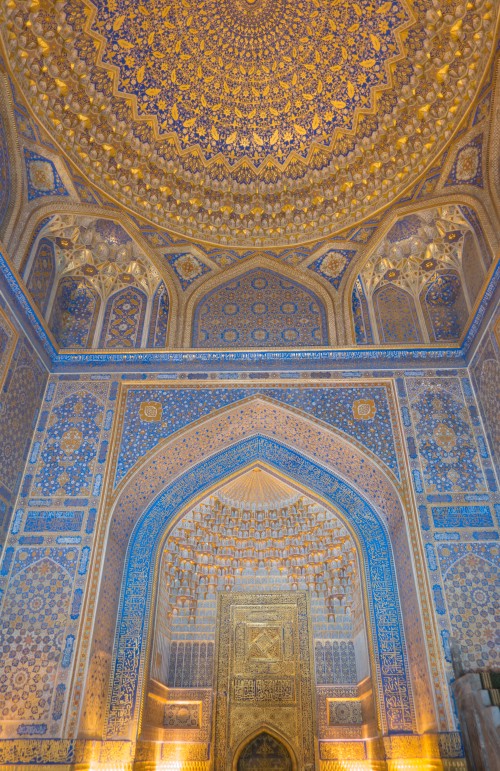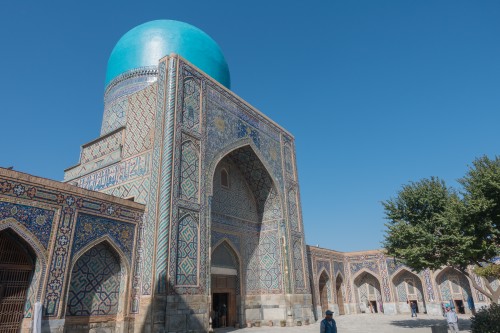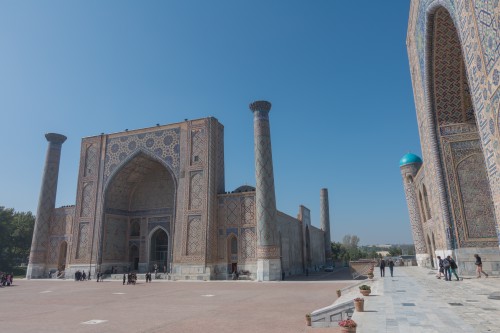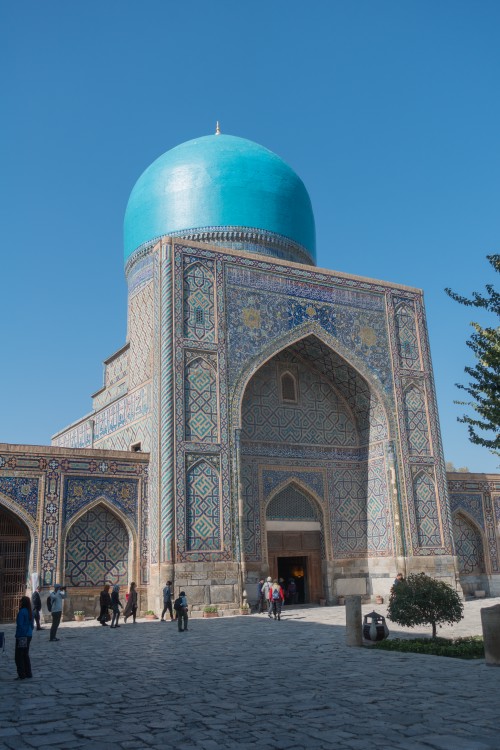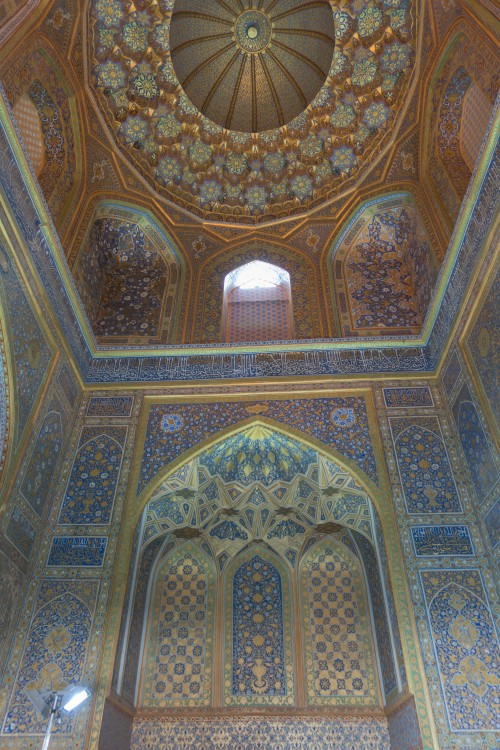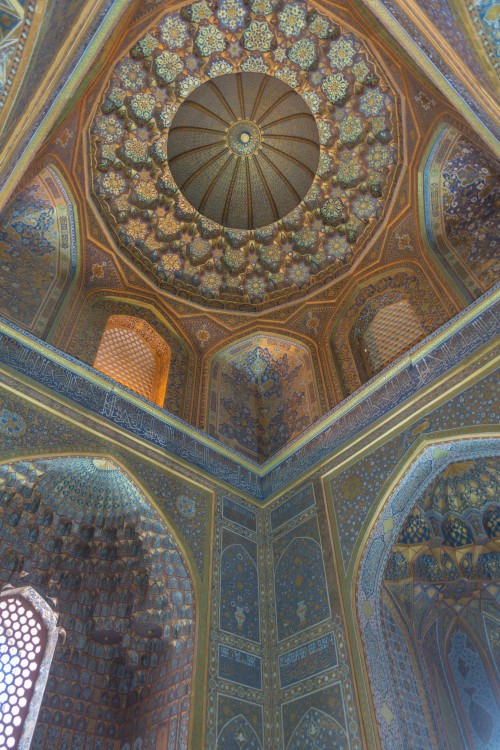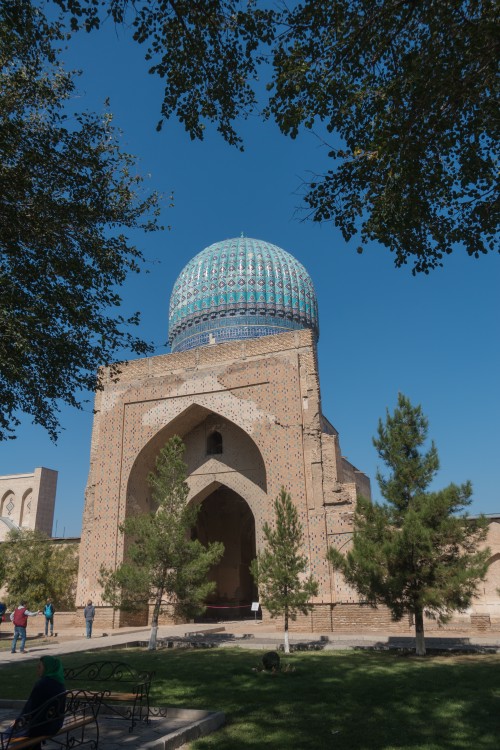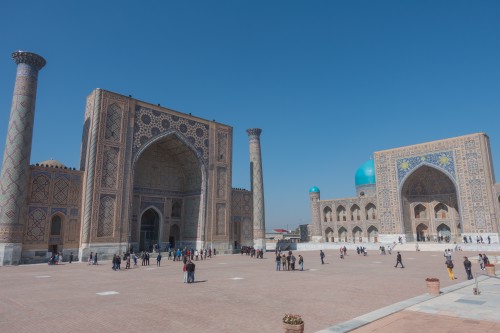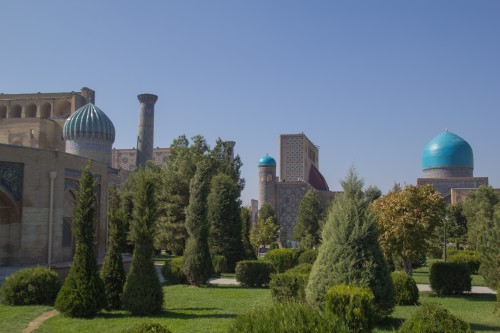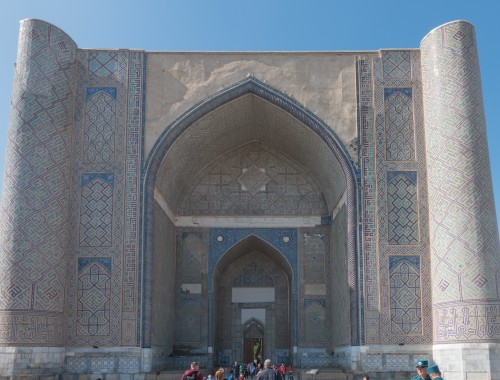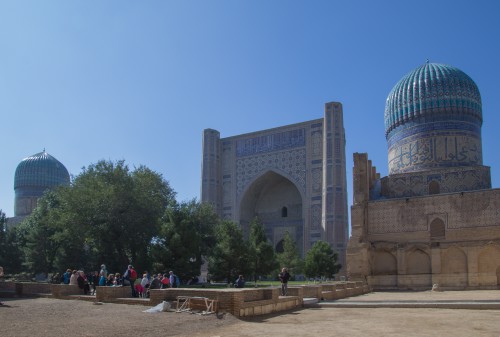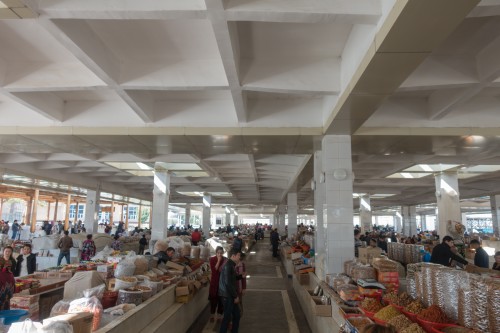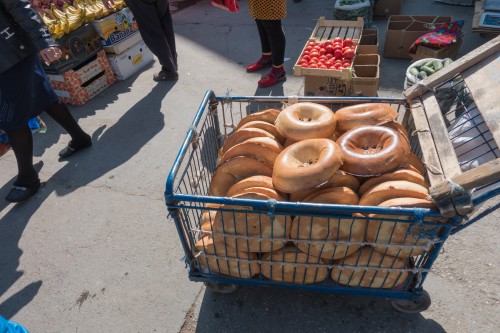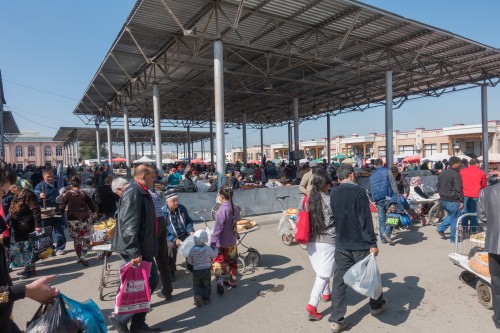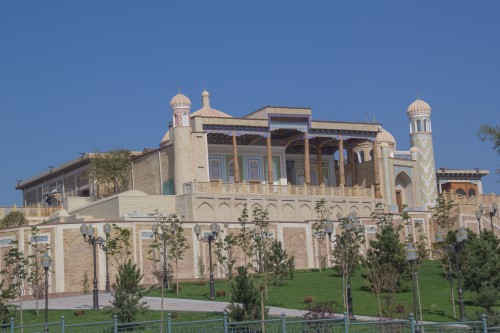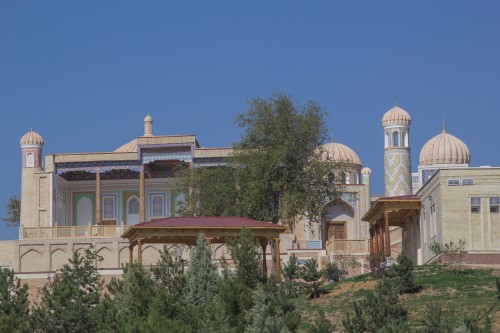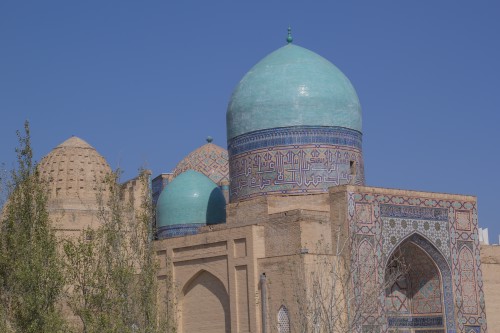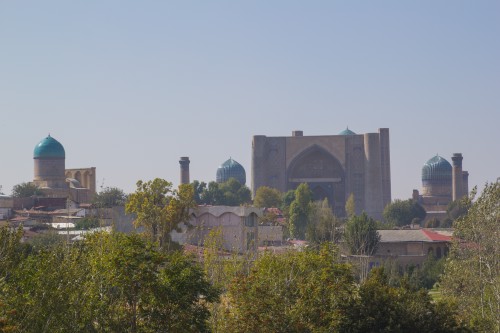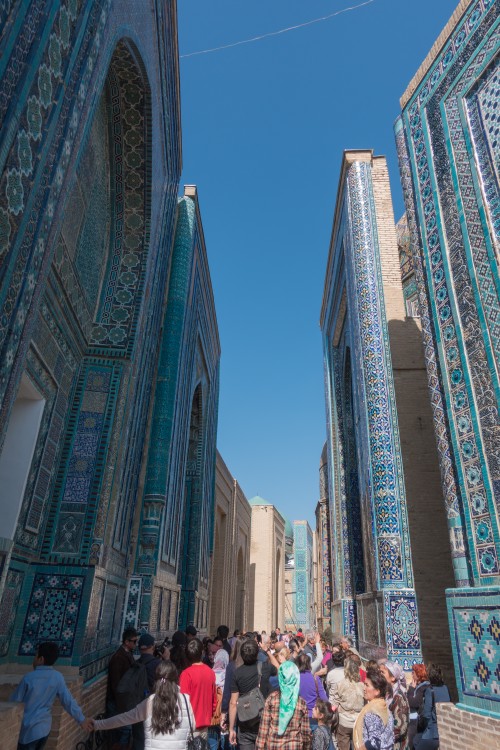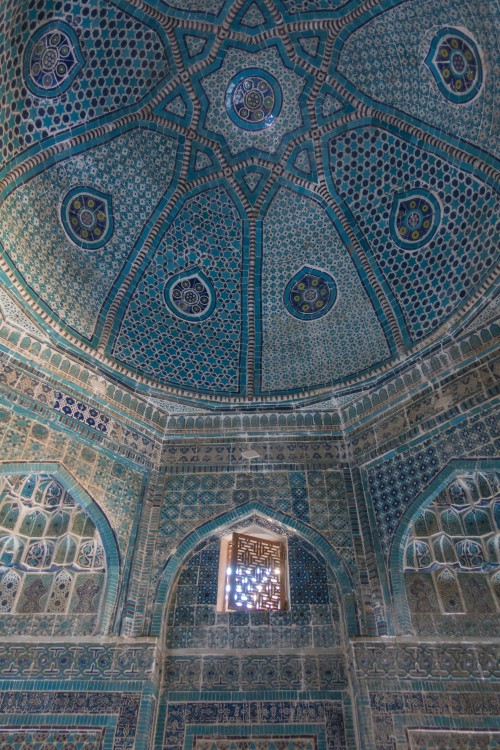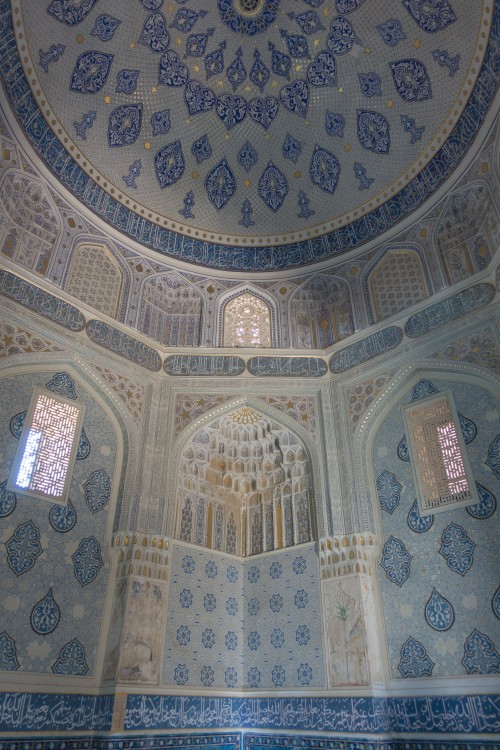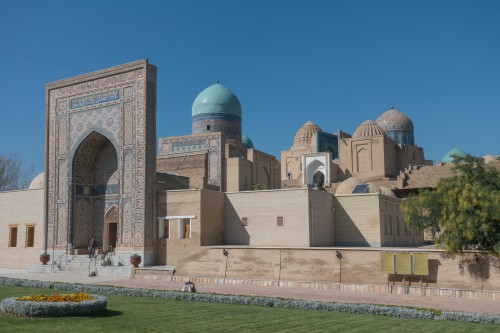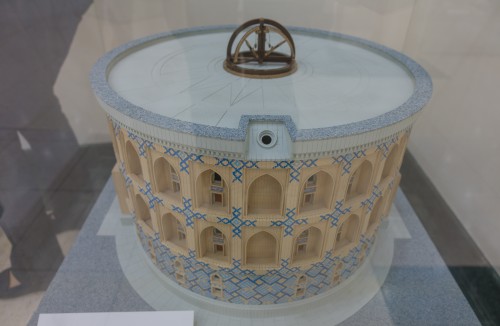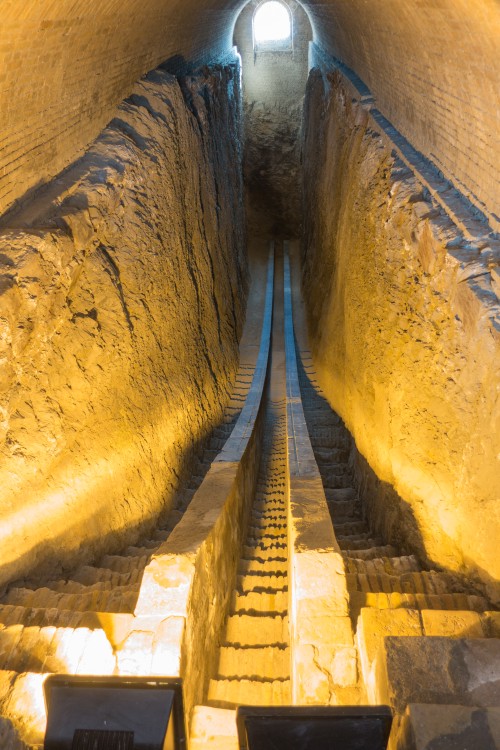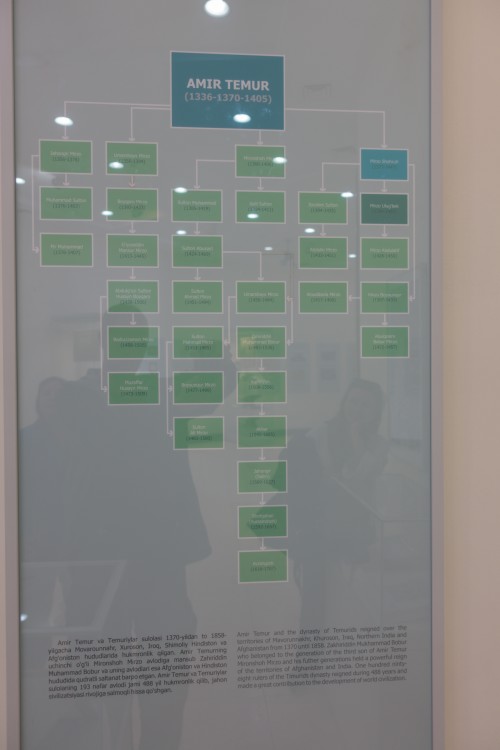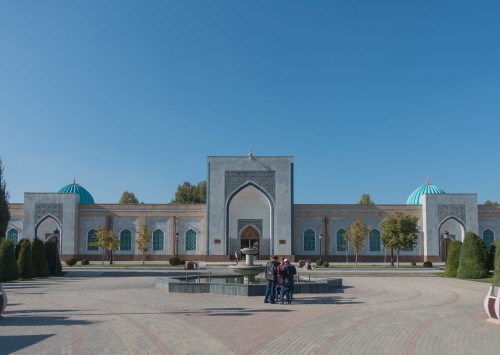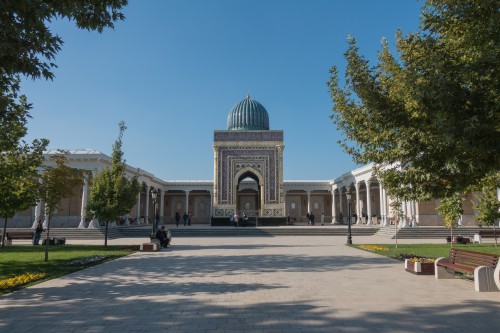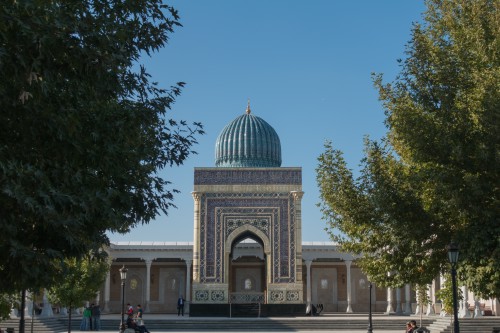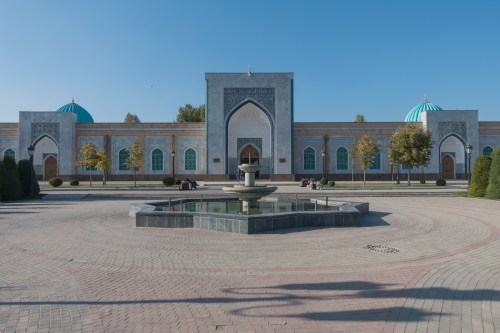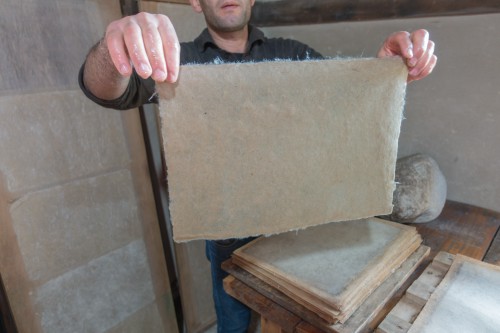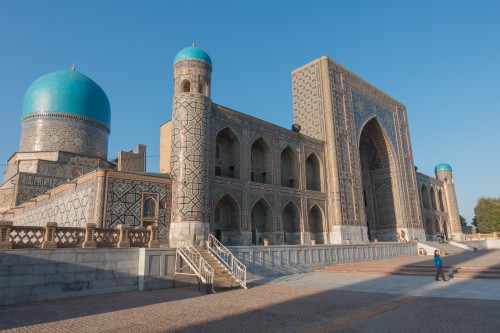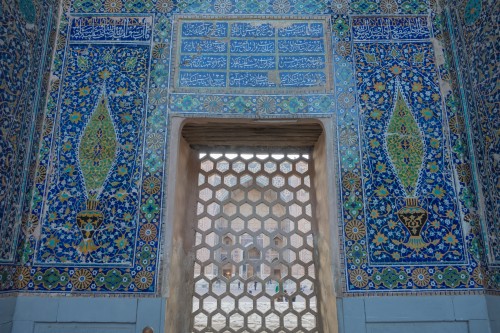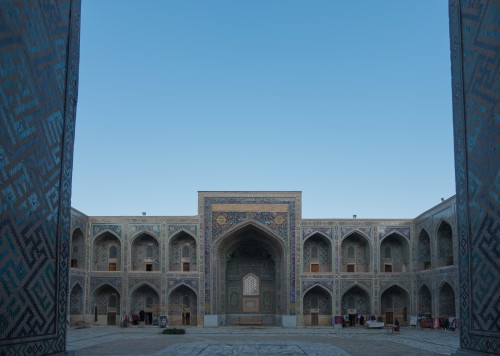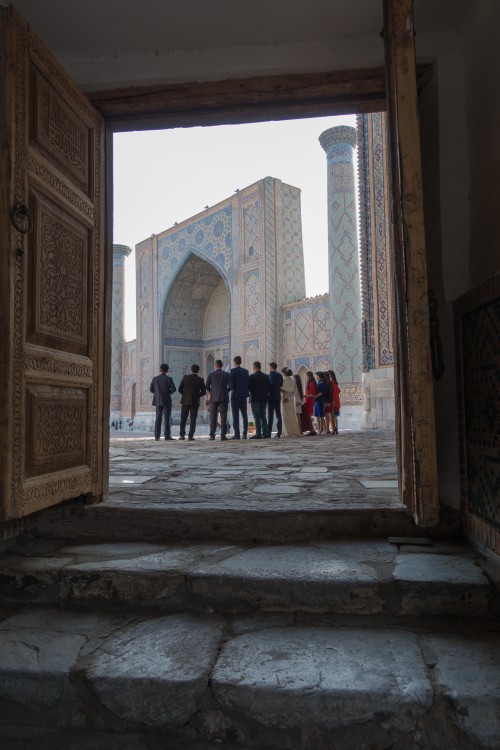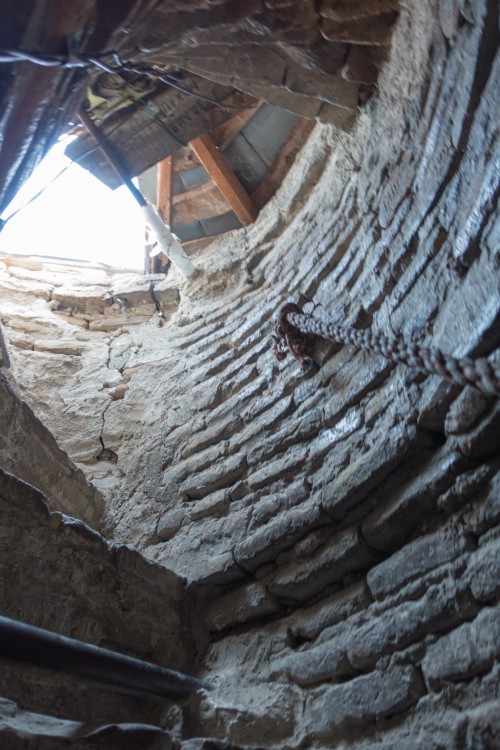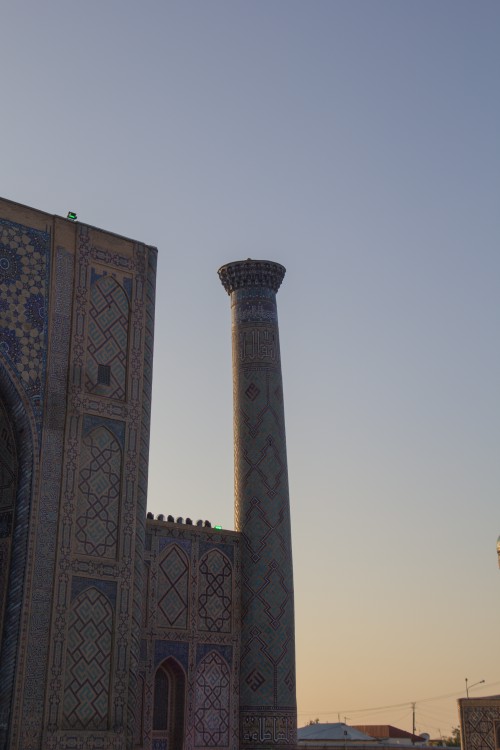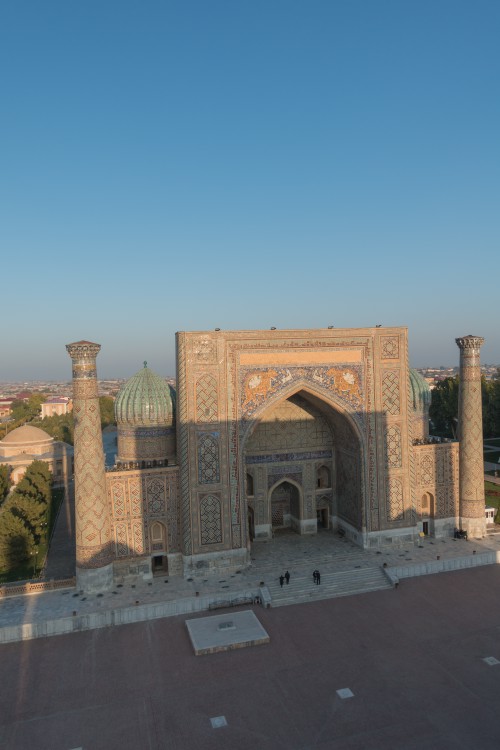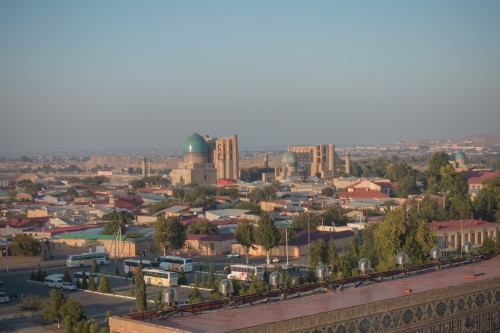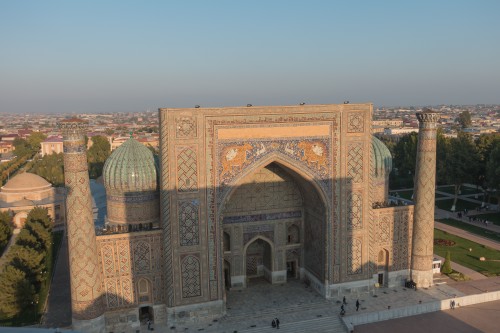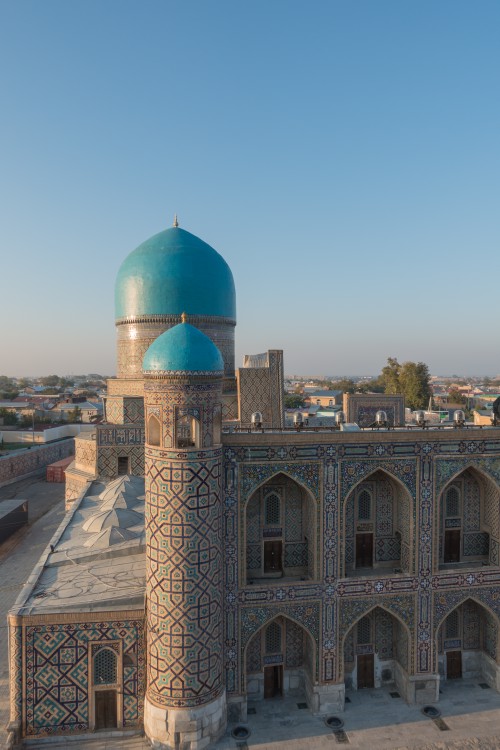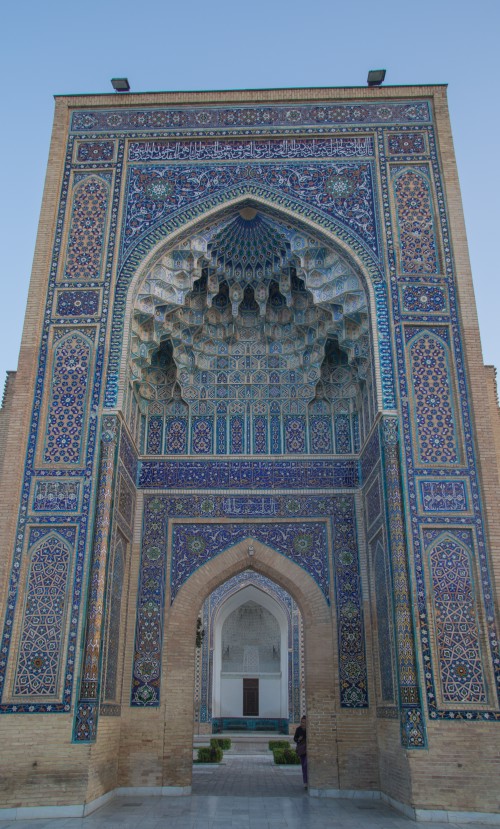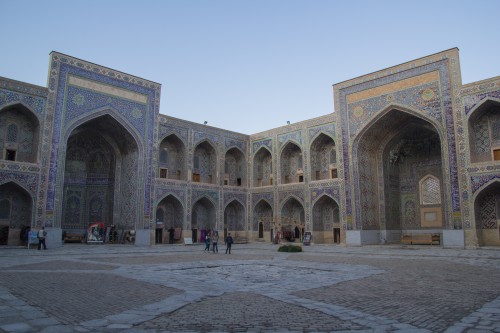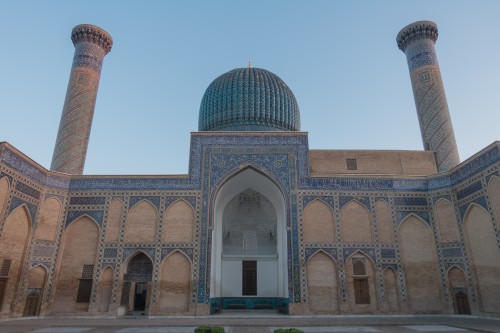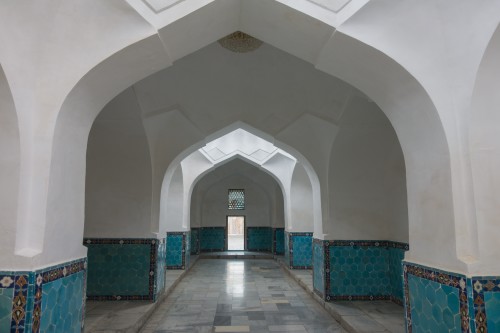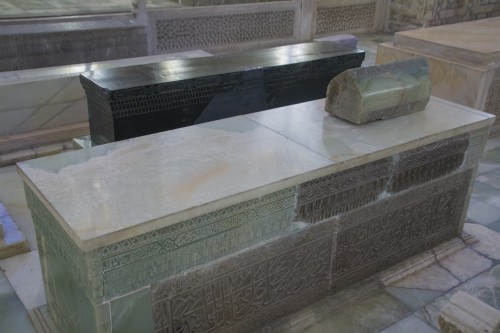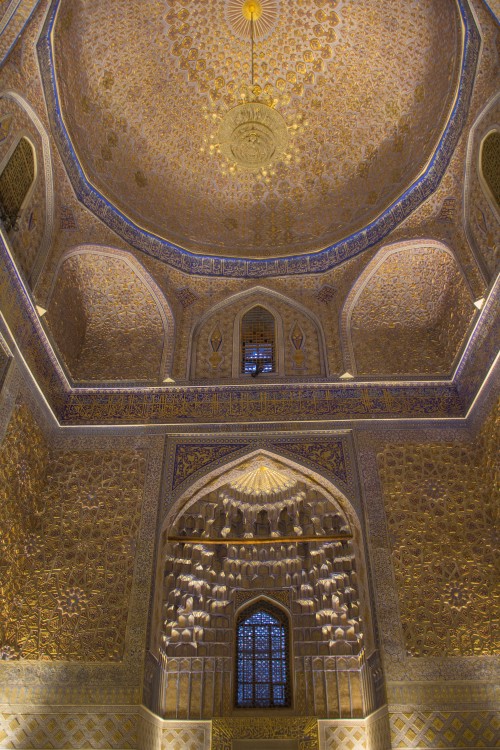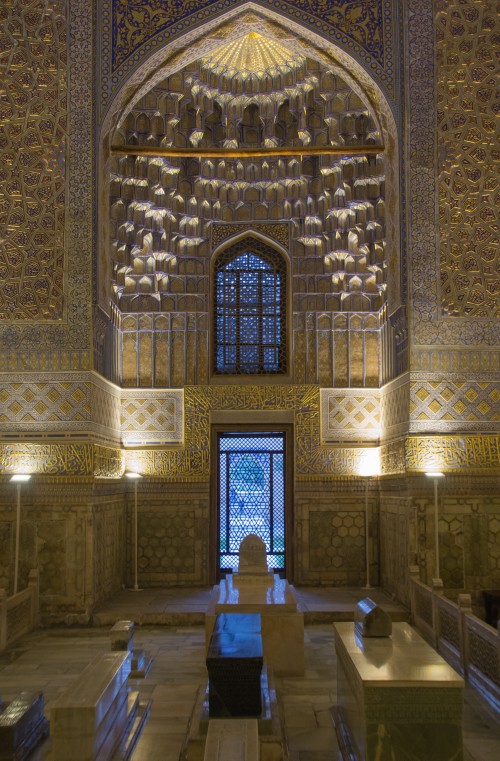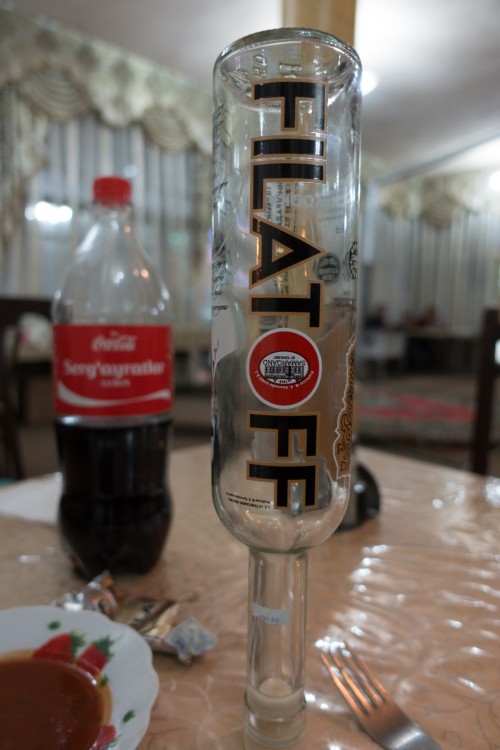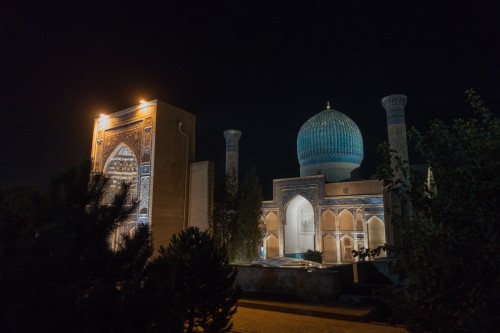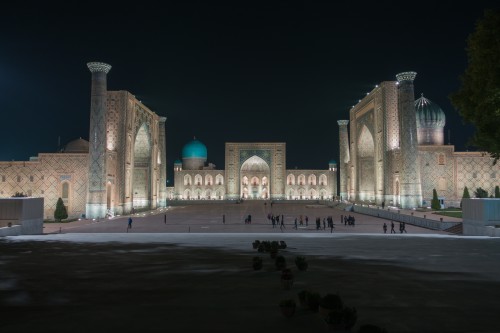We were up at 8, and took our first shower in a while that didn't leak. The room was an upgrade over the Bukhara room in every way, except for the bed. It was not quite a v-shaped as the bed at Gorilla's Nest in Rwanda, but the bed was not remotely flat - we each kept rolling towards the center. Breakfast, like so many of our breakfasts on this trip, was underwhelming. Perhaps breakfast isn't that big a deal in this part of the world. We certainly didn't need any more calories.
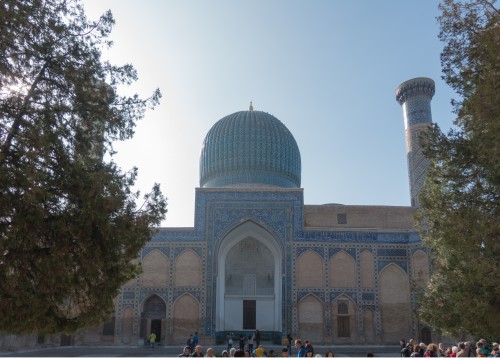 |
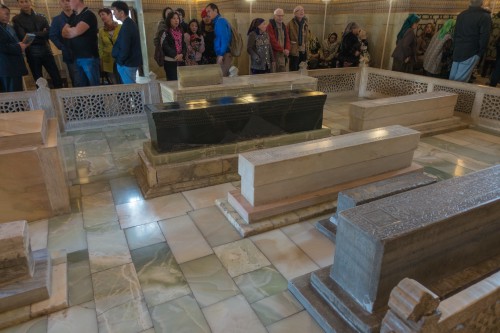 |
We met our guide Della at 9. We tried to find some money at an ATM or get some exchanged, but we were having no luck because it was a Sunday. The big nearby hotel had its exchange closed. A big bank was open, but the cash exchange lady was not there. Thankfully Firdacz was able to find a place, and we were on our way. Then we drove back to right where we started, and saw the Gur-e-Amir. Interestingly, Timur was supposed to be buried at the nearby town of Shahrisabz, but when he died in the winter of 1405 the passes to Shahrisabz were closed, so Timur was buried in Samarkand instead.
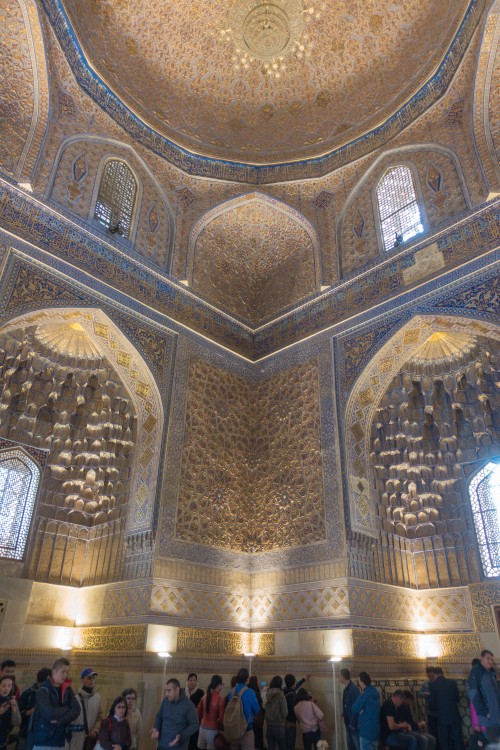 |
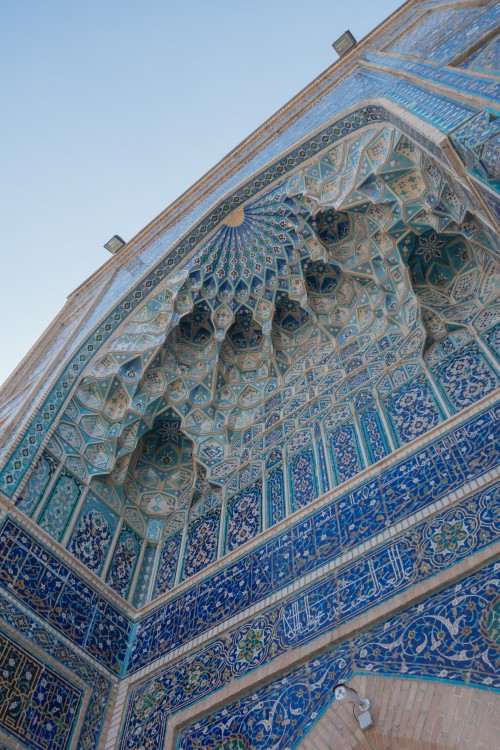 |
There were lots of people there, and there were tiny hallways, so we were brushing past people. Despite this, there were some people who had tripods with them, and were trying to set them up - very tone-deaf. The mausoleum had carved headstones in a room directly above the actual graves. Timur's headstone was a solid piece of dark green (almost black) jade. Besides Timur, two of his sons, two of his grandsons (including Ulugbek), and his spiritual advisor. The hallway from the entry door to the main chamber was filled with white and turquoise, and it looked great. This made us hopeful for our master bathroom remodel, which was going to be exclusively these two colors.
To head to the Registan, we actually got back in the car and drove; it was much faster. It was nice and sunny outside, and warmer again. Today we actually found out was everything was. The three massive buildings were all madrasahs. The original building, on the western side of the complex, was the Ulugbek madrasah. It was built between 1417 and 1420. Ulugbek, in addition to being head of the empire, was also one of the leading mathematicians and astronomers of the times. The next madrasah built was the facing one, on the east side of the complex, called Sher-Dor madrasah. It was built between 1619 and 1636. It was supposed to be a match of the Ulugbek madrasah. Shortly after this was finished, people realized that the complex was missing something, so ten years later they started the Tilya-Kori madrasah.
We started our tour in the Ulugbek madrasah. The interior courtyard was actually multi-level. Della told us that what we were looking at today was largely rebuilt by the Soviets in 1970s. Samarkand started on the decline at the end of the 1600s, and then there was a bad earthquake in the 1800s. Della told us that the damage was so bad that one of the minarets had to be righted. Indeed, it still wasn't completely straight even now. The restoration including kilos of gold leaf. We next viewed the Tilya-Kori madrasah, which had a mosque inside of it. There was a museum with old photos, and it was incredible to see how much restoration was put in. The mosque had an incredibly ornate ceiling, which actually was an optical illusion to make it look like a dome when in fact it was only barely rounded. At the third madrasah, the Sher-Dor, Della showed us how the rooms used to be utlized when it was an Islamic school. As in Bukhara, now most all of the stalls in the madrasah were full of crafts for sale.
As we did yesterday, we left the Registan and walked down Tashkent Street, slowly. Della asked us if we wanted to use one of the golf cart shuttles to head down the street, but it was nice outside so we said no. In hindsight, we should have, for Della's benefit. We weren't sure if she was walking slowly because she wasn't able to walk much faster, or if she was just used to walking with older tourists and had a deliberately slow pace. But eventually we got the Bibi-Khanum mosque.
After Timur came back from India in 1399, he decided to build a giant mosque in Samarkand, using wealth taken from India, to memorialize the occasion. When he returned from the next big military campaign in 1404, the mosque was almost completed, but Timur was not happy with it, so he changed the design. This led to various structural issues, and the mosque started to slowly fall apart almost from day one. But like everything else in Samarkand (and Bukhara and Khiva for that matter), it was restored by the Soviets around 40-50 years ago. [Below shows a restored portion (left) and un-restored (right).] It seems ironic that on the one hand the Soviets stopped the practice of Islam by its citizens, but at the same time spent a small fortune to restore old Muslim mosques, minarets and madrasahs.
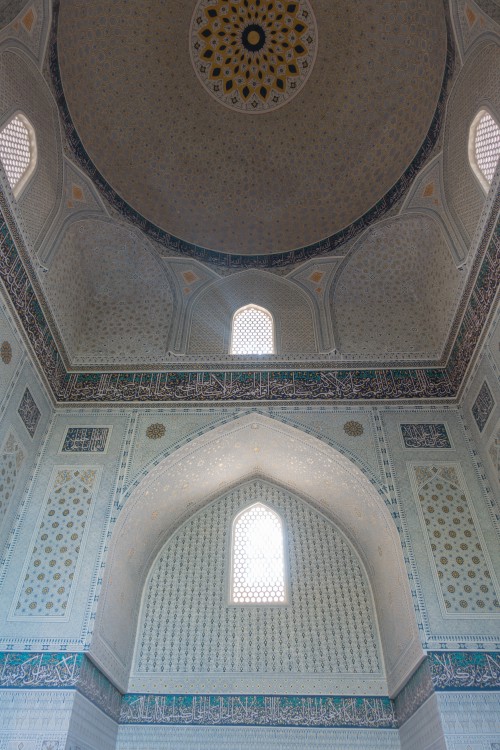 |
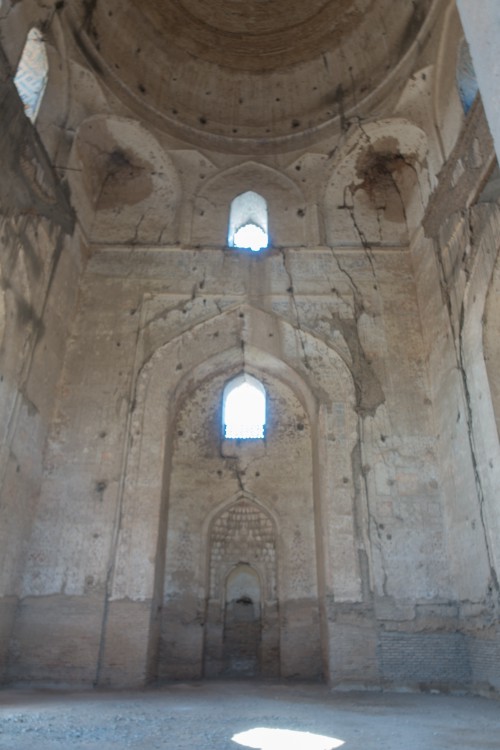 |
Across the street from the Bibi-Khanum mosque was a mausoleum for his favorite wife (Bibi Khanum, the person for whom the mosque was named). We didn't go in, but it looked nice from the outside. Our next stop was at the nearby bazaar. There was a ton of dried fruits and nuts and bread everywhere. The plants looked somewhat similar to what we would see at nurseries in California. From the bazaar we walked to the northeast, passing by Hazrat Khizr Mosque (and the mausoleum of recently deceased President Karimov) on the way to the necropolis complex, Shah-i-Zinda.
The necropolis was full of lots of blue and turquoise all over the outside and inside of the mausoleums. Crystal was wearing these colors, so she was camoflauged in the horde of people. Like elsewhere in Uzbekistan, there was some original stuff and lots of restoration. The mausoleums were built over nine centures, from the 1000s to the 1800s. There are more than 20 different buildings. The name Shah-i-Zinda means "the living king" and relates to the story that the cousin of the prophet Muhammad - Kusam ibn Abbas - was buried there. He was one of the earliest to breach Islam in the Samarkand area, and his mausoleum is revered. There was in fact a prayer room in his mausoleum complex, which was a bit awkward because there were also noisy tourists all about, and in very tight quarters.
We took a short drive further east to eat lunch at a local place, right next to the Ulugbek observatory. On the drive, we noticed the area to the east of the necropolis was barren, which seemed odd in the middle of a big city. The reason that it is barren is because there is belief that there are valuable ruins under this. Samarkand is arguably the oldest, continuously inhabited city in the world, and the part to the east of the necropolis may house some of the oldest ruins. Lunch was fried lamb for Justin, lamb kebab for Crystal. We also shared some soda and a salad. The food was good, but nowhere near the top of the list on this trip. We had no idea we were going to see an observatory, and surprised there was one. [We read the original itinerary long ago.] It shouldn't be that surprising, however, given that Ulugbek was a leading astronomer at the time. Most of the observatory was destroyed (and this time, not rebuilt) by religious fanatics in 1449. But there were the remains of a massive sextant for observing the sun, moon, and other celsetial bodies. Based on this tool, the astronomers could determine noon ever day. All sorts of discoveries were made, and the astronomers could predict eclipses and calculate the sunrise and sunset. Based on measurements, they calculated a year was 365 days, 6 hours, 10 minutes and 8 seconds, only about 1 minute longer than the commonly accepted length today.
The sextant reminded us of a giant measurement tool that we saw in Jaipur, India a few years ago. When we got inside, we realized this wasn't coincidental. In fact, Timur and Ulugbek's family tree had several descendants who traveled to India and started the Moghul empire, including Shah Jahan, who built the Taj Mahal in Agra. These relatives actually built the astronomical tools we had seen in Jaipur. We had absolutely no idea. Apparently the Gur-e Amir complex was one of the inspirations or influences for the Taj Mahal. Again, we had no clue. Like we said, lots of inter-related history here. Also inside the museum were miniatures of the observatory and several other of the Samarkand complexes, where you could see the interior courtyards and everything all at once. Samarkand would probably be a great place for balloon rides if there were a safe place to land them.
Back in the car, we drove a little outside of town and went to the Imam Bukhari Mosque. Unlike everything else, this mosque is basically new, built post-independence. It had a really nice layout, and was full of donations from other countries. Given that we can't go to Mecca or Medina, besides Jerusalem this is probably the holiest Islam site we'll be able to see. There were hardly any tourists. There is a covered mausoleum near the back of the complex, a large courtyard with trees, and prayer areas and museum on the side. The museum had donations from basically every country with a sizeable Muslim population. Ones we remember included the Philippines, Malaysia, Indonesia, Iran, the other 'Stans, and pretty much every country from the Middle East and North Africa. There were undoubtedly more.
 |
On the drive back into town, we stopped at a paper mill, and saw how they made paper from the mulberry trees. It was interesting, but frankly sort of a dud to end the tour with. But on the plus side, Justin temporarily got feeling back in his right hand. It didn't last long, unfortunately. [In hindsight, the cold water probably just numbed everything, so everything felt the same.] Della and Firdacz said this was a sign we should come back to Samarkand in the future. Maybe we will, even if just to eat and drink. Rather than get dropped at the hotel, we asked Firdacz to drop us at the Registan. We said goodbye to Della there, and then walked around to places we wanted to spend more time and/or see in the afternoon light. Some lady asked if we wanted to go up the tallest minaret, as she could arrange that. We initially said no, but after walking around elsewhere, Justin inquired again. It was $5, which seemed worth it. Crystal didn't want any more sore quads, so she stayed on the ground. As it turns out, the tallest minaret is in the Ulugbek madrasah, and is the one that isn't remotely vertical. When the Soviets rebuilt the minarets, they didn't finish the tops (as no one calls for prayer from the top of the minarets any more), so the view from the top of the minaret is by you sticking your head out the top like a prairie dog. The walk up and down was much easier, as the steps were bigger, the corridor was lit, and the people in charge of the minaret made sure only one person was in the stairwell at a time. The view was spectactular, but also a bit terrifying.
On the way back, we encountered the loud group of birds again. Last night around dusk we had heard them as well. It reminded Justin of the bird flocks that make so much noise in downtown Houston around dusk and dawn. The birds almost drowned out the traffic noise - almost. At the Amir Timur park we split up. Crystal still had her cold, and went back to the room to rest up. Justin went back to Gur-e-Amir complex, as our tickets were good for the day. It was much nicer with fewer people, and there was hardly anyone there. It was much easier to see things from the various vantage points. He also searched again for the plov restaurant, but with no success. Back in the room, we read, backed up photos, checked news, etc. We got up a little after 7 for dinner. Just as Justin was getting up from the desk, he got an email from the podcast host, and found out the plov place was not actually near us. Rather, the person who had eaten the plov in Samarkand was picked up by a taxi driver in front of the Gur-e Amir, but the restaurant was at some other (unknown) place in town.
So instead we went back to the same place as the night before, since when we walked by the kebabs looked and smelled good. They didn't have those, however (they were just for take-out), so we got their fried chicken, plus some soup and bread. We also got a bottle of vodka and a bottle of Coke. Fried must mean "stir fried" or something similar in Central Asia, as the only deep fried item we've had was the chicken at lunch in Bukhara. The chicken was absolutely phenomenal; we immediately added it to the list of great meals in our history, which was now heavily skewed to just the last 7-10 days. Who would have guessed Uzbekistan? Perhaps when there is no fish and no pork, everything else gets extra attention. Uzbekistan is one of only two "doubly" landlocked countries - meaning every country that borders it is landlocked itself - so we are a long way from the ocean. Somehow this got us on the subject of how fish end up in certain places, such as alpine lakes and rivers thousands of miles from the ocean; we never figured out a reasonable answer. We finished the bottle of vodka, but couldn't finish all the chicken. We leisurely walked our way back to the hotel, enjoying one final evening in Samarkand.






